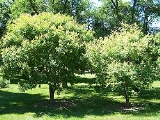
Maackia
Encyclopedia
Maackia is a genus of 11 species of flowering plant
s in the family Fabaceae
, native to eastern Asia
.
They are small to medium-sized deciduous
tree
s typically growing 10-15 m tall. The leaves
are compound pinnate, with 7-17 leaflets. The flower
s are fragrant, white, yellowish, or greenish, produced in raceme
s 5-20 cm long. The fruit
is a pod 3-8 cm long, containing one to six seeds.
The genus is related to Cladrastis
, differing in having the leaflets arranged in opposite pairs (not alternately), the buds not being hidden in the leaf base, and in the twigs not being brittle.
Maackia was named after the botanist Richard Maack
.
Species
Flowering plant
The flowering plants , also known as Angiospermae or Magnoliophyta, are the most diverse group of land plants. Angiosperms are seed-producing plants like the gymnosperms and can be distinguished from the gymnosperms by a series of synapomorphies...
s in the family Fabaceae
Fabaceae
The Fabaceae or Leguminosae, commonly known as the legume, pea, or bean family, is a large and economically important family of flowering plants. The group is the third largest land plant family, behind only the Orchidaceae and Asteraceae, with 730 genera and over 19,400 species...
, native to eastern Asia
Asia
Asia is the world's largest and most populous continent, located primarily in the eastern and northern hemispheres. It covers 8.7% of the Earth's total surface area and with approximately 3.879 billion people, it hosts 60% of the world's current human population...
.
They are small to medium-sized deciduous
Deciduous
Deciduous means "falling off at maturity" or "tending to fall off", and is typically used in reference to trees or shrubs that lose their leaves seasonally, and to the shedding of other plant structures such as petals after flowering or fruit when ripe...
tree
Tree
A tree is a perennial woody plant. It is most often defined as a woody plant that has many secondary branches supported clear of the ground on a single main stem or trunk with clear apical dominance. A minimum height specification at maturity is cited by some authors, varying from 3 m to...
s typically growing 10-15 m tall. The leaves
Leaf
A leaf is an organ of a vascular plant, as defined in botanical terms, and in particular in plant morphology. Foliage is a mass noun that refers to leaves as a feature of plants....
are compound pinnate, with 7-17 leaflets. The flower
Flower
A flower, sometimes known as a bloom or blossom, is the reproductive structure found in flowering plants . The biological function of a flower is to effect reproduction, usually by providing a mechanism for the union of sperm with eggs...
s are fragrant, white, yellowish, or greenish, produced in raceme
Raceme
A raceme is a type of inflorescence that is unbranched and indeterminate and bears pedicellate flowers — flowers having short floral stalks called pedicels — along the axis. In botany, axis means a shoot, in this case one bearing the flowers. In a raceme, the oldest flowers are borne...
s 5-20 cm long. The fruit
Fruit
In broad terms, a fruit is a structure of a plant that contains its seeds.The term has different meanings dependent on context. In non-technical usage, such as food preparation, fruit normally means the fleshy seed-associated structures of certain plants that are sweet and edible in the raw state,...
is a pod 3-8 cm long, containing one to six seeds.
The genus is related to Cladrastis
Cladrastis
Cladrastis kentukea, the Kentucky Yellowwood or American Yellowwood , is a species of Cladrastis native to the Southeastern United States, with a restricted range from western North Carolina west to eastern Oklahoma, and from southern Missouri and Indiana south to central Alabama...
, differing in having the leaflets arranged in opposite pairs (not alternately), the buds not being hidden in the leaf base, and in the twigs not being brittle.
Maackia was named after the botanist Richard Maack
Richard Maack
Richard Otto Maack was a 19th century Russian naturalist, geographer, and anthropologist. He is most known for his exploration of the Russian Far East and Siberia, particularly the Ussuri and Amur River valleys...
.
Species
- Maackia amurensisMaackia amurensisThe tree species Maackia amurensis is commonly known as the Amur maackia. The species epithet and common names are from the Amur River region, where the tree originated....
Rupr. & Maxim. Northern China, Korea, northern Japan, southeastern Siberia. - Maackia australis (Dunn) Takeda. Southern China.
- Maackia chekiangensis Chien. Eastern China.
- Maackia ellipticocarpa Merr. Hong Kong.
- Maackia fauriei (Lévl.) Takeda. Korea.
- Maackia floribunda (Miq.) Takeda. Central and southern Japan.
- Maackia hupehensis Takeda. Central China.
- Maackia hwashanensis W.T.Wang. Central China.
- Maackia taiwanensisMaackia taiwanensisMaackia taiwanensis is a species of legume in the Fabaceae family.It is found only in Taiwan.-References:* Lu, S.Y. & Pan, F.J. 1998. . Downloaded on 19 July 2007....
Hoshi & Ohashi. Taiwan. - Maackia tashiroi (Yatabe) Makino. Southern Japan (Kyūshū, Ryukyu IslandsRyukyu IslandsThe , also known as the , is a chain of islands in the western Pacific, on the eastern limit of the East China Sea and to the southwest of the island of Kyushu in Japan. From about 1829 until the mid 20th century, they were alternately called Luchu, Loochoo, or Lewchew, akin to the Mandarin...
). - Maackia tenuifolia (Hemsl.) Hand.-Mazz. Eastern China.
External links
- Maackia amurensis Diagnostic photographs and information, Morton ArboretumMorton ArboretumThe Morton Arboretum, in Lisle, Illinois, covers 1,700 acres and is made up of gardens of various plant types and collections of trees from specific taxonomical and geographical areas. It includes native woodlands and a restored Illinois prairie. The Arboretum has over 4,100 different species of...
acc. 147-71-5

